Expanding Balance Sheets and Monetizing Debt to Engineer Economic Recovery
Economics / Recession 2008 - 2010 Aug 10, 2009 - 02:14 AM GMT Economy - Green shoots are starting to sprout all over the place - so say the talking heads, as they spin, spin, spin - adding new dimensions to the ancient craft of whirling dervishes.
Economy - Green shoots are starting to sprout all over the place - so say the talking heads, as they spin, spin, spin - adding new dimensions to the ancient craft of whirling dervishes.
When you go out to pick tomatoes or weed the garden this weekend, appreciate the natural beauty of green shoots and how they come to be, both in germination and fruition, and notice what fights hard to take over their place in your garden.
Personal income fell 1.3% in June, following a revised 1.3% increase in May. Consumer spending increased 0.4% from May's 0.1% rise.
Year-over-year personal income fell -3.4% during June, following a -2.2% decline in May. Year-ago core PCE inflation eased to 1.5% from 1.6% in May.
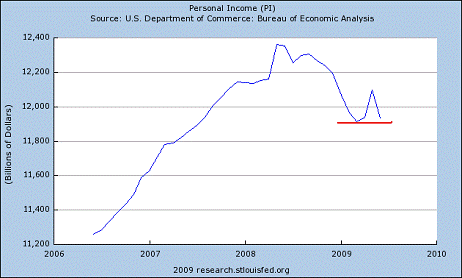

The Commerce Department reported that wages and salaries dropped 4.7% during the 12 months through June. This was the largest decline since 1960, the year the records were first kept track of.
This is not a good thing. As I pointed out last week - these are some of the most important sectors/data streams that must improve if the consumer is to keep his head above water, thus allowing the economy to stay afloat.
As if the above negative data reports aren't enough, home prices continue to drop through the floor, reducing household net worth by a record $13.9 tri0llion since 2007. That number is about the same as the GDP of the U.S. on a yearly basis.
All of the above data supports the thesis that the consumer is between a rock and a hard place: income is falling while prices rise. Some call it stagflation, albeit quite mild at the moment. Let's hope it stays that way or improves. No sustainable green shoots here, at least not yet.
Initial jobless claims fell 38,000 to 550,000 (prior week revised 4,000 higher to 588,000). The current level is right at the four-week average of 555,250, more than 50,000 lower than the average at the end of June.
Continuing claims were up 69,000 to 6.31 million. The four-week average is almost 500,000 lower than the same time-frame in June.

Nonfarm payroll employment decreased 247,000 in July, following a revised decline of 443,000 in June. On a year-ago basis, payroll jobs were down 4.2 percent in July, compared to down 4.1 percent the month before. Wage inflation rose 0.2 percent. The average workweek edged up to 33.1 hours from 33.0 hours in June. The civilian unemployment rate dropped to 9.4 percent from 9.5 percent in June. The last two are slight improvements.
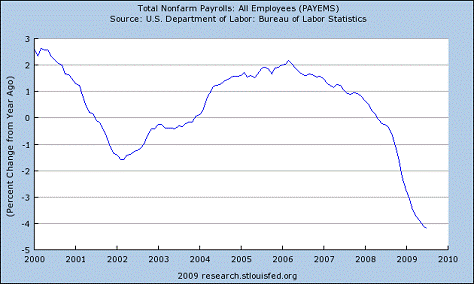
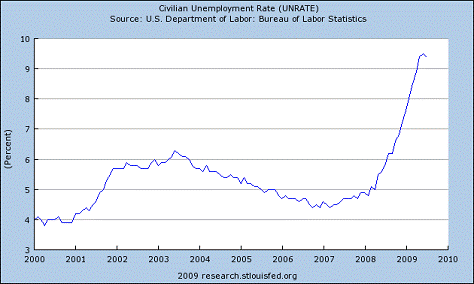
Outstanding consumer credit continued to contract in May, falling $3.2 billion after a huge drop of $16.5 billion in April. This is just another sign that the consumer is hard pressed and cutting back from their prior "spend to you drop" syndrome present during the prior boom years, which has now gone bust.

Factory orders slowed in June, to plus 0.4% from a 1.1% advance in May. Note that nondurables gained 2.7% compared to a 2.2% decline for durable goods.
Inventories declined just under 1%. Note that on a year on year basis orders are down -24%. Obviously, this is not a good thing - regardless of how they try to spin it.

The Bank of England (BOE) added 50 billion pounds ($84 billion) to its asset purchase plan, which is substantially higher than the Treasury originally approved. Bank of England Governor Mervyn King has now injected 175 billion pounds into the economy, equivalent to 12% of the gross domestic product.
Immediately following the public announcement of the change in monetary policy, the market responded with a 1% drop in the pound against the dollar. The news caught many traders off guard, as they were expecting the policy to end sooner rather than later.
The bank said that the pound's weakness has caused inflationary expectations to rise, putting upward pressure on consumer prices. Consequen0tly, the British currency (pound) has fallen 9% from a year ago.
This is all in keeping with the currency devaluation game of musical chairs the central banks are playing around the world. The dollar is stronger because it is less weak than the pound for example.
The BOE has now stated that is it prepared to buy as much as 22% of all outstanding U.K. government bonds. Now that's what you call monetizing the debt. This is not a good thing, but it does bode well for gold.
The European Central Bank (ECB) has not gone down the road of qualitative easing as quickly or to the extent that the U.S. and Britain has. Thus far, the ECB has only purchased 5.1 billion euro's ($7.3 billion) in covered bonds. Instead, it has been concentrating on injecting money into the economy by implementing various refinancing policies.
Yet, unemployment remains high at 9.4%. European Central Bank President Jean-Claude Trichet reiterated his concern with unemployment after leaving rates unchanged this past week, saying:
"We will have to accept that unemployment will have to augment, maybe significantly, and that will have a bearing on the evolution of growth. We have to remain ourselves very cautious and also very prudent."
Now, after reading the various economic reports that came out this week and hearing my comments concerning them, as opposed to the spin the various news media reports about them, I'm going to quote a number of paragraphs from a speech William C. Dudley, President and Chief Executive Officer of the Federal Reserve Bank of New York gave at the Association for a Better New York Breakfast Meeting, Grand Hyatt, New York, last week. Please note that some of the comments are taken out of context, however, the general gist of what was being said obtains; as a matter of fact, you will note that President Dudley's comments are much closer to mine than they are to the mainstream news headlines. He remains cautious and well aware of the potential pitfalls that lurk ahead.
Dudley: The Economic Outlook and the Fed's Balance Sheet: The Issue of "How" versus "When" (click link for full transcript of speech)
Regardless of the precise timing, there are a number of factors which suggest that the pace of recovery will be considerably slower than usual. In particular, I expect that consumption -- which accounts for about 70 percent of gross domestic product -- is likely to grow slowly for three reasons. First, real income growth will probably be weak by historical standards.
Second, households are still adjusting to the sharp drop in net worth caused by the persistent decline in home prices and last year's fall in equity prices. This suggests that the desired saving rate will not decline sharply. That means consumer spending is unlikely to rise much faster than income. In other words, weak income growth will be an effective constraint on the pace of consumer spending.
Perhaps most important, the normal cyclical dynamic in which housing, consumer durable goods purchases and investment spending rebound in response to monetary easing is unlikely to be as powerful in this episode as during a typical economic recovery. The financial system is still in the middle of a prolonged adjustment process. Banks and other financial institutions are working their way through large credit losses and the securitization markets are recovering only slowly. This means that credit availability will be constrained for some time to come and this will serve to limit the pace of recovery.
These are very important issues so let's reiterate them one more time. President Dudley mentions three factors that suggest the pace of the recovery will be slow. They are:
- Weak real income growth
- Weak consumer spending
- Monetary easing will have a diminished effect
Notice that these are the exact reports and data results seen early in the report: income down, consumer spending down, factory orders down, consumer credit down, high unemployment, etc. I tend to agree with Mr. Dudley, as opposed to the talking heads on the television - any recovery will be slow and hard fought. To think otherwise is simply wishful thinking.
Moving on, we have the second part of his speech, which covers a somewhat different subject:
Several firm-specific interventions in which the Federal Reserve has taken on illiquid asset portfolios from Bear Stearns and AIG, with the goal of managing and liquidating these asset portfolios over time in a manner that is in the best interests of the federal government and the U.S. taxpayer.
These programs have led to significant changes in both the composition and size of the Federal Reserve's balance sheet. For example, in August 2007, prior to the onset of the crisis, the Federal Reserve's balance sheet was about $870 billion. Currently, the size of the balance sheet is about $2 trillion.
The size of the Federal Reserve's balance sheet seems likely to grow to roughly $2.5 trillion, somewhat above the peak reached last December. At present, these balance-sheet issues do not appear to be having a meaningful effect on bank behavior. In fact, the excess reserves serve as a liquidity buffer that many banks find attractive in the current environment. But that does not mean we can ignore this issue. We need to keep this issue in mind as we contemplate how much balance-sheet expansion might be appropriate.
Third, the Federal Reserve is taking on some interest-rate risk in terms of its balance sheet. The excess reserves have an overnight maturity. These liabilities are being used to purchase longer-term assets. In principle, if short-term interest rates were to move up very sharply, the cost of funding could eventually exceed the return on the Fed's assets. The bigger our balance sheet, the greater the amount of interest-rate risk we are assuming.
I am pleasantly surprised at Mr. Dudley's candor in explaining some of the potential problems the Fed faces, however, I think there may be others lurking in the shadows. The interest rate risk he discusses is not to be dismissed lightly; it could have grave consequences, of which he seems well aware. There is not time here to delve into it in detail. Suffice he is aware.
However, I'm more concerned with what was said in the very beginning of the comments quoted. How are illiquid assets that the Fed now holds, going to be liquidated, without the Fed losing money on the transaction - if the transaction can even be made?
This is something I think the Fed and the Treasury have never had a handle on - how could they; a toxic waste derivative that is illiquid is still the same beast it was before and after the Fed purchases it.
Now that the Fed has all this toxic waste in its balance sheet - what the hell are they going to do with it? Who are they going to off-load (sell) it to? Where were these mysterious buyers of all things toxic when the market needed them? And why will they show up now? This is wishful thinking at best and delusional at worst.
The charts below show the machinations of the Fed's balance sheet and the money supply before, during, and since the crisis unfolded. Recall that President Dudley has called for the Fed's balance sheet to expand to 2.5 TRILLION later this year.
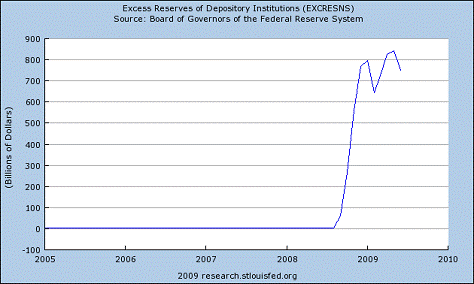
What the Fed needs to be sure of is that it carries a powerful weed killer in its bag of tricks that does no harm to the green shoots other than the weeds that try to choke them off from their needed sustenance for survival. The chart below shows the recent changes in the Fed's balance sheet, which are still at high levels.

Commodities
Commodities, stocks, oil, and gold have all been rallying since March. We are going to go through a few different commodity charts, both in the type of commodity offered (charted) and in regards to the time frame of the chart data under review. Our goal is to try to discern any tell tale signs that might be hinting at where commodities are most likely to go from here.
Up first is the Reuters equal weighted CCI index, where all the commodities have equal weighting in the make-up of the index, as opposed to the CRB index that is not weighted and where oil dominates the composition of the index. Hence, CCI gives a much "purer" overall commodity read.
Since March 2009 the CCI has rallied from 341 to 430 for approximately a 23% gain. The index is overbought and ripe for a pull-back to at least 400.
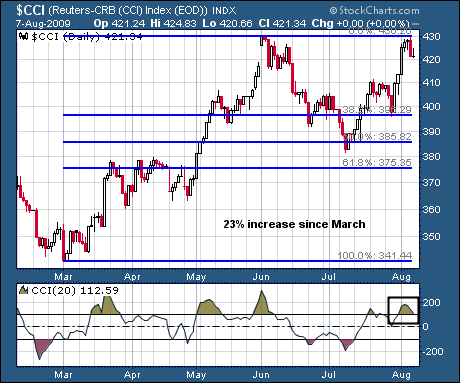
Oil had a huge move up to new highs in 2008 near $148 dollars a barrel. Then the collapse in prices came, from $148 all the way down to $35 per barrel - a devastating loss. Many were crushed on both sides of the trade. It was not a pretty site.
The United States Oil Fund (USO) bottomed out at 22.74 in late Feb. From there oil rallied to its June high at 40 (USO). That represented a gain of about 74% in less than 4 months time.
Since March, USO has corrected from 40 down to 31, which represents 9 points or a 50% retracement of its gain from its low at (22) to its high at (40). Notice horizontal support goes from mid-July back to the April - May time frame. Presently, price sits near 38 and is bumping into stiff overhead resistance. CCI is overbought and headed towards zero, a break of which suggests a further correction is most likely.
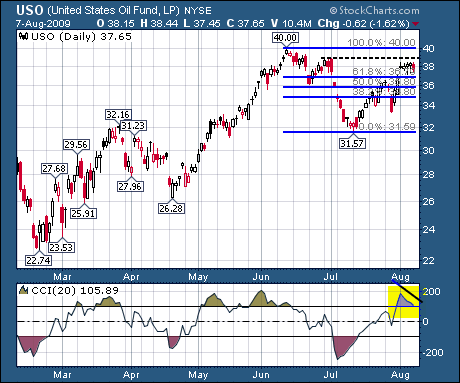
Copper has been one of the strongest performers so far this year. One of the reasons for this performance is that copper fell by one of the greatest margins; hence it had plenty of lost ground to make up for. The second reason is that supposedly, if the global recovery regains its footing, China and other major nations will need lots of copper to build houses, cars, and other gadgets with. There is also the idea that certain nations (China) are putting more of their "money" into hard commodities (copper, gold, etc.) as opposed to paper assets (T-bonds, etc.). I see evidence that supports both sides of the argument.
The chart below shows copper falling from just over 400 in July 2008, to 125 during Dec. 2008, a precipitous drop of 275 points or almost 68%. Since Dec. copper has been on a tear - rallying up to 278 for a 153 points for a spectacular gain of 122%. It is ripe for a pull-back.

Humming right along with copper have been many of the other industrial metals, as represented by the DBB Index. Since March, the DBB has rallied 74%; and since July it has gained 32.4%. This is an extended market with open gaps that appears to be susceptible to some profit taking.
An abandoned baby candlestick formation formed at the end of this week. If it is confirmed by a black candle to the downside it could signal a start in a commodity correction that is a bit overdue. A lot depends on the dollar. So let's take a look at the dollar.
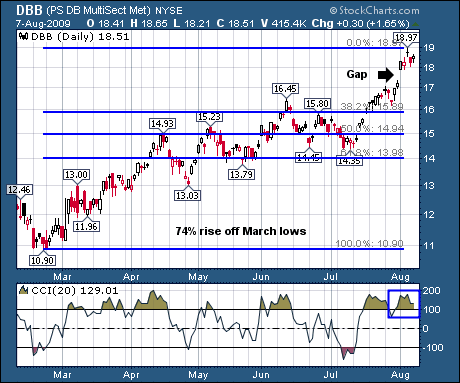

Gold
Gold added $1.16 for the week for a +0.17% gain, closing at $955.70 (continuous contract). As noted in the currency section, the dollar also closed up slightly on the week. The relation between the two should be monitored.
I have not read the full agreement, so I don't want to say too much until I've had time to study it, however, it has been reported that the European central banks agreed to a new (third) five-year cap on gold sales and said sales by the International Monetary Fund could be done within the agreement (note - this doesn't mean it has to or that it will).
The European Central Bank, along with 18 other signature banks, agreed to sell no more than 400 metric tons of gold a year through September 2014. Presently, the cap is 500 tons.
So far this year the world's central banks have sold 73% less gold than in previous years. The IMF wants to sell 403 tons from its reserves of 3,217 tons, which is the third largest holding in the world.
The IMF has not signed the accord, which means it could sell to the Chinese or Russians or any other non-signature central bank.
On the daily chart below a triangle is forming. The upper boundary is marked by 972. Gold needs to close above this price to make a run at its highs. There is a good deal of horizontal support at 948 - 960 (yellow band). If this level is closed below then the July low at 930 comes into play.
MACD is still under a positive cross over with the histograms slowly receding back towards zero. STO has curled over and put in a negative cross and looks like it's getting ready to move down and out of overbought territory (momentum waning).
CCI has moved out of overbought territory and below 100 (71), signaling a loss of momentum. However, these signals could change in a heartbeat - price action trumps all else. At this time the weight of the evidence points slightly down.

Next up is the weekly chart. It still shows the inverse head & shoulders formation intact and ready to rock and roll. The projected upside target is $1300.00.
CCI has turned up and is headed towards overbought territory (bullish). MACD is still negative, but it looks like it is getting ready to make a positive cross over, which would be quite constructive. The chart looks promising.
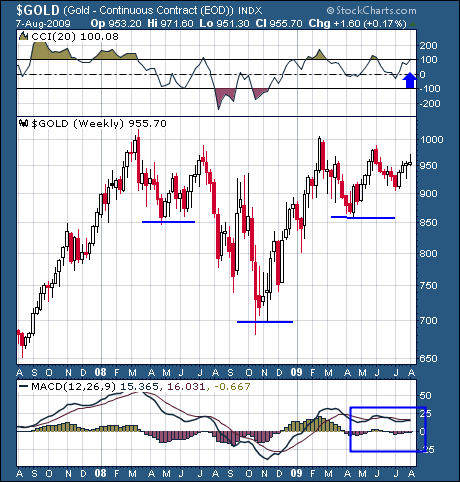
Silver
Silver had a good week, gaining almost 5%, closing at $14.62 (continuous contract). Silver outperformed both gold and the pm stocks this past week. Last week this report discussed how silver was undervalued to gold and that at some point it would pay catch up - it played some this past week.
First up is the daily chart of silver with the Fibonacci retracement levels overlaid from the June highs to the July lows. Notice that price is bumping up into its 61.8% fib retracement level. Also, CCI is well into overbought territory. Taking some profits at this stage would not be unreasonable, as some type of correction or consolidation seems likely to work off the overbought readings.
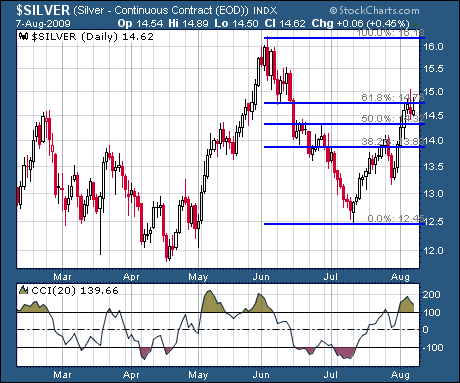
The above excerpt is a small sampling from the latest full-length version (42 pgs) of this week's market wrap report, available only at the Honest Money Gold & Silver Report website. This week's report goes into the details of foreign currencies and their inter-market relations with stocks, bonds, and commodities; including gold and silver.
All major markets are covered with the emphasis on the precious metals, as that is the one market that is in a secular bull market where the profit to ratio is in the investors favor. The markets are at important inflection points right now, and there will be some big winners and big losers just ahead. The turbulent times caused by the financial crisis have not yet receded. There are more unpleasant surprises to come. A free trial subscription to help you navigate through these unchartered waters is available by submitting a request to: dvg6@comcast.net.
Stop by and check out the myriad forms of information available, not only on investing, but on the history of gold and silver money as mandated by the U.S. Constitution, which is the answer to the present financial crisis and one's own financial protection from the loss of purchasing power resulting from the use of paper money.
Some of the resources available on the website are:
- Glossary of terms
- Beginners Intro Area
- Links to Central Banks
- Kids Corner on Savings
- E-book - Honest Money
- Open Letter to Congress
- Live charts of most markets
- Audio-book - Honest Money
- Open Letter to Audit the Fed
- Archives of past market wrap reports
- Links to educational sites on a variety of subjects
- Archives of past editorials and articles by Douglas Gnazzo
- Links to International Organizations (IMF, WB, BIS, etc.)
- Linked articles to top writers on economics, monetary theory, & law
- Live bulletin board where you can talk to investors around the world
- Links to worldwide news agencies (Reuters, London Times, Guardian)
Good luck. Good trading. Good health, and that’s a wrap.

Come visit our website: Honest Money Gold & Silver Report
New Audio-Book Now Available - Honest Money
Douglas V. Gnazzo
Honest Money Gold & Silver Report
About the author: Douglas V. Gnazzo writes for numerous websites and his work appears both here and abroad. Mr. Gnazzo is a listed scholar for the Foundation for the Advancement of Monetary Education (FAME).
Disclaimer: The contents of this article represent the opinions of Douglas V. Gnazzo. Nothing contained herein is intended as investment advice or recommendations for specific investment decisions, and you should not rely on it as such. Douglas V. Gnazzo is not a registered investment advisor. Information and analysis above are derived from sources and using methods believed to be reliable, but Douglas. V. Gnazzo cannot accept responsibility for any trading losses you may incur as a result of your reliance on this analysis and will not be held liable for the consequence of reliance upon any opinion or statement contained herein or any omission. Individuals should consult with their broker and personal financial advisors before engaging in any trading activities. Do your own due diligence regarding personal investment decisions. This article may contain information that is confidential and/or protected by law. The purpose of this article is intended to be used as an educational discussion of the issues involved. Douglas V. Gnazzo is not a lawyer or a legal scholar. Information and analysis derived from the quoted sources are believed to be reliable and are offered in good faith. Only a highly trained and certified and registered legal professional should be regarded as an authority on the issues involved; and all those seeking such an authoritative opinion should do their own due diligence and seek out the advice of a legal professional. Lastly Douglas V. Gnazzo believes that The United States of America is the greatest country on Earth, but that it can yet become greater. This article is written to help facilitate that greater becoming. God Bless America.
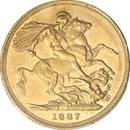
Douglas V. Gnazzo © 2009 All Rights Reserved
© 2005-2022 http://www.MarketOracle.co.uk - The Market Oracle is a FREE Daily Financial Markets Analysis & Forecasting online publication.



